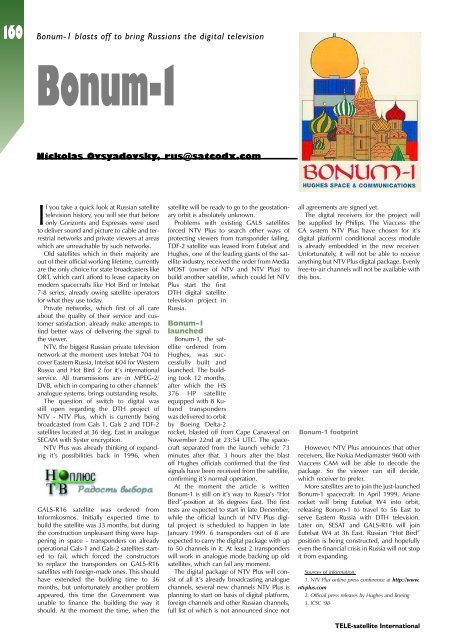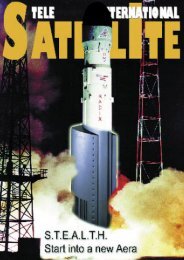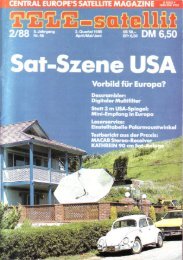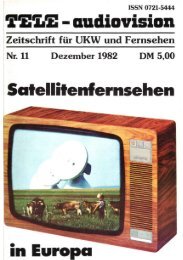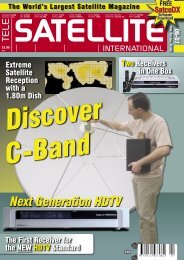Bestellen Sie diesen Satelliten- Newsletter! - TELE-satellite ...
Bestellen Sie diesen Satelliten- Newsletter! - TELE-satellite ...
Bestellen Sie diesen Satelliten- Newsletter! - TELE-satellite ...
You also want an ePaper? Increase the reach of your titles
YUMPU automatically turns print PDFs into web optimized ePapers that Google loves.
160<br />
Bonum-1 blasts off to bring Russians the digital television<br />
Bonum-1<br />
Nickolas Ovsyadovsky, rus@satcodx.com<br />
If you take a quick look at Russian <strong>satellite</strong><br />
television history, you will see that before<br />
only Gorizonts and Expresses were used<br />
to deliver sound and picture to cable and terrestrial<br />
networks and private viewers at areas<br />
which are unreachable by such networks.<br />
Old <strong>satellite</strong>s which in their majority are<br />
out of their official working lifetime, currently<br />
are the only choice for state broadcasters like<br />
ORT, which can’t afford to lease capacity on<br />
modern spacecrafts like Hot Bird or Intelsat<br />
7-8 series, already owing <strong>satellite</strong> operators<br />
for what they use today.<br />
Private networks, which first of all care<br />
about the quality of their service and customer<br />
satisfaction, already make attempts to<br />
find better ways of delivering the signal to<br />
the viewer.<br />
NTV, the biggest Russian private television<br />
network at the moment uses Intelsat 704 to<br />
cover Eastern Russia, Intelsat 604 for Western<br />
Russia and Hot Bird 2 for it’s international<br />
service. All transmissions are in MPEG-2/<br />
DVB, which in comparing to other channels’<br />
analogue systems, brings outstanding results.<br />
The question of switch to digital was<br />
still open regarding the DTH project of<br />
NTV - NTV Plus, which is currently being<br />
broadcasted from Gals 1, Gals 2 and TDF-2<br />
<strong>satellite</strong>s located at 36 deg. East in analogue<br />
SECAM with Syster encryption.<br />
NTV Plus was already thinking of expanding<br />
it’s possibilities back in 1996, when<br />
GALS-R16 <strong>satellite</strong> was ordered from<br />
Informkosmos. Initially expected time to<br />
build the <strong>satellite</strong> was 33 months, but during<br />
the construction unpleasant thing were happening<br />
in space - transponders on already<br />
operational Gals-1 and Gals-2 <strong>satellite</strong>s started<br />
to fail, which forced the constructors<br />
to replace the transponders on GALS-R16<br />
<strong>satellite</strong>s with foreign-made ones. This should<br />
have extended the building time to 36<br />
months, but unfortunately another problem<br />
appeared, this time the Government was<br />
unable to finance the building the way it<br />
should. At the moment the time, when the<br />
<strong>satellite</strong> will be ready to go to the geostationary<br />
orbit is absolutely unknown.<br />
Problems with existing GALS <strong>satellite</strong>s<br />
forced NTV Plus to search other ways of<br />
protecting viewers from transponder failing.<br />
TDF-2 <strong>satellite</strong> was leased from Eutelsat and<br />
Hughes, one of the leading giants of the <strong>satellite</strong><br />
industry, received the order from Media<br />
MOST (owner of NTV and NTV Plus) to<br />
build another <strong>satellite</strong>, which could let NTV<br />
Plus start the first<br />
DTH digital <strong>satellite</strong><br />
television project in<br />
Russia.<br />
Bonum-1<br />
launched<br />
Bonum-1, the <strong>satellite</strong><br />
ordered from<br />
Hughes, was successfully<br />
built and<br />
launched. The building<br />
took 12 months,<br />
after which the HS<br />
376 HP <strong>satellite</strong><br />
equipped with 8 Kuband<br />
transponders<br />
was delivered to orbit<br />
by Boeing Delta-2<br />
rocket, blasted off from Cape Canaveral on<br />
November 22nd at 23:54 UTC. The spacecraft<br />
separated from the launch vehicle 73<br />
minutes after that. 3 hours after the blast<br />
off Hughes officials confirmed that the first<br />
signals have been received from the <strong>satellite</strong>,<br />
confirming it’s normal operation.<br />
At the moment the article is written<br />
Bonum-1 is still on it’s way to Russia’s “Hot<br />
Bird”-position at 36 degrees East. The first<br />
tests are expected to start in late December,<br />
while the official launch of NTV Plus digital<br />
project is scheduled to happen in late<br />
January 1999. 6 transponders out of 8 are<br />
expected to carry the digital package with up<br />
to 50 channels in it. At least 2 transponders<br />
will work in analogue mode backing up old<br />
<strong>satellite</strong>s, which can fail any moment.<br />
The digital package of NTV Plus will consist<br />
of all it’s already broadcasting analogue<br />
channels, several new channels NTV Plus is<br />
planning to start on basis of digital platform,<br />
foreign channels and other Russian channels,<br />
full list of which is not announced since not<br />
all agreements are signed yet.<br />
The digital receivers for the project will<br />
be supplied by Philips. The Viaccess (the<br />
CA system NTV Plus have chosen for it’s<br />
digital platform) conditional access module<br />
is already embedded in the new receiver.<br />
Unfortunately, it will not be able to receive<br />
anything but NTV Plus digital package. Evenly<br />
free-to-air channels will not be available with<br />
this box.<br />
Bonum-1 footprint<br />
However, NTV Plus announces that other<br />
receivers, like Nokia Mediamaster 9600 with<br />
Viaccess CAM will be able to decode the<br />
package. So the viewer can still decide,<br />
which receiver to prefer.<br />
More <strong>satellite</strong>s are to join the just-launched<br />
Bonum-1 spacecraft. In April 1999, Ariane<br />
rocket will bring Eutelsat W4 into orbit,<br />
releasing Bonum-1 to travel to 56 East to<br />
serve Eastern Russia with DTH television.<br />
Later on, SESAT and GALS-R16 will join<br />
Eutelsat W4 at 36 East. Russian “Hot Bird”<br />
position is being constructed, and hopefully<br />
even the financial crisis in Russia will not stop<br />
it from expanding.<br />
Sources of information:<br />
1. NTV Plus online press conference at http://www.<br />
ntvplus.com<br />
2. Official press releases by Hughes and Boeing<br />
3. ICSC ‘98<br />
<strong>TELE</strong>-<strong>satellite</strong> International


